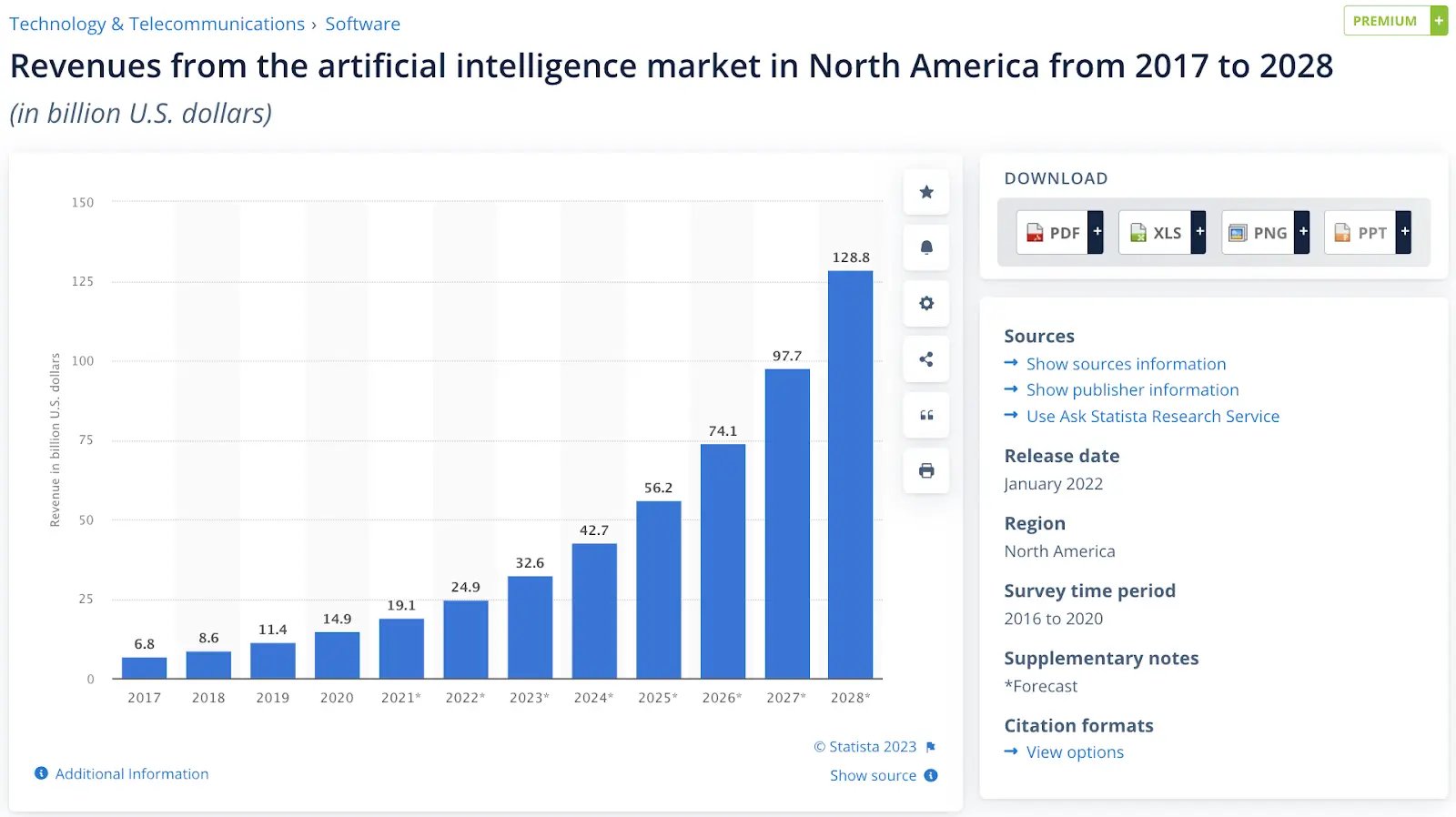Did ChatGPT’s temporary shutdown wreak havoc on society?
Absolutely.
Does that take away from the fact that artificial intelligence (AI) can potentially transform content creation for your digital customer academy?
Absolutely not.
This article looks at the rise of AI, its application in the world of content creation and, most importantly, how you can use the technology to create content your customers will love.
Jump to Content
- The Rise of Artificial Intelligence (AI)
- AI in Digital Customer Education
- How AI is Transforming Content Creation
- Creating AI-generated Content for Your Digital Customer Academy
The Rise of Artificial Intelligence (AI)
Person of Interest is one of my all-time favorite TV shows. It’s a gem, but there’s no denying it paints a not-so-great picture of AI.
Still, there are plenty of people giddy about the technology.
In North America alone, total revenues from the artificial intelligence market are expected to reach $128.8b by 2028, up from $6.8b in 2017. That’s an increase of more than 1,700%.

The use cases for AI are endless but most commonly tied to industries like healthcare, financial services, transportation, retail, energy, and manufacturing.
In healthcare, for example, healthcare professionals (HCPs) will likely use AI for data-based diagnostic support.
Meanwhile, Walgreens is using AI to track the spread of the flu, and Northface uses it to help consumers find the perfect coat.
These are the headline-grabbing use cases, but the rise of AI is trickling into other industries, including customer education.
While still early in its evolution, AI is helping customer education teams create more impactful content with fewer resources.
AI in Digital Customer Education
Like most technology, the ways customer education teams can use AI are constantly growing. That said, the current use cases primarily revolve around a handful of core functions: chat-based support, measurement, and content.
I’ll touch on the first two use cases before diving into AI’s impact on content creation.
-
Measurement: Instead of sifting through reporting, AI tools will show relevant metrics on learner-level engagement and content impact.
-
Workflow automation: AI will show information about a customer’s learning and assign relevant courses. For example, if they fail a quiz more than 3 times, the AI-powered learning management system (LMS) can send them helpful content.
That level of innovation is right around the corner.
AI-powered content creation is already here.
How AI is Transforming Content Creation
As a content marketer, I’ve read a lot about how AI is coming for my job. This article, “Does Content Marketing’s Love for AI Make Writers Obsolete?” paints a compelling picture.
Am I worried about a robot taking my job? Not really, but I’d be lying if I said there wasn’t a small part of me that wonders about the inevitable advancements. So, ask me again in ten years.
For now, I don’t lose sleep because I don’t see AI as a replacement for writers. Rather, I see it as an augmentation—an extension, if you will. And that’s how I see AI impacting content creation for customer education teams.
These tools are thought starters, and a means to accelerate content creation, especially for teams with limited resources.
Need a video script for a video about industry best practices? Done.
Stuck on an outline for a learning path about a new product feature? AI can help.
Think of AI as a launchpad or like Power Flowers in Super Mario 64. It’s there to help you make content faster and more impactful, not create it from start to finish.
Here’s how easy it can be…
I know that was fast—it was supposed to be.
In just over 2 minutes, ChatGPT gave me the following:
-
An outline for my course
-
A video script for each section of my course
-
A one-question quiz for each section
-
5 potential names for the course
-
A short course description
-
An email I can use to promote the course to my customers
Imagine what it could do if I refined the prompts…
Again, ChatGPT and other AI aren’t meant to replace content creators. They’re meant to accelerate the process.
Creating AI-generated Content for Your Digital Customer Academy
AI-driven content creation isn’t a plug-and-play sort of thing. It’s a rocket booster, but there’s some legwork on your part to ensure the outputs hit the nail on the head.
Define Goals & Objectives
Goals provide direction for your content. Having these in place ensures that what you’re creating—and what you’re asking AI to help you with—is relevant, engaging, and meets your customers’ needs.
While it’s important to go to your leadership team to understand their goals related to customer acquisition, lifetime value, expansion, etc., your goals should really come from your customers and team.
What outcomes are your customers expecting?
What’s worked in the past? What hasn’t?
Which formats do your customers prefer?
These conversations will give you the data and insight you need to develop the specifics and overarching themes of your content. They’ll also help you provide the AI tools with the inputs it needs to churn out content that proves valuable.
Gather Data & Information from Subject Matter Experts (SMEs)
It’s time to start accumulating the relevant data and information you’ll need to ensure your content delivers the intended impact.
Seek out the subject matter experts (SMEs) at your company and use their in-depth knowledge of the product and how it works to outline the direction of your content, appropriate formats, and what your customers will need to make the most of it.
They’ll know what you’ll have to have to ensure your customers’ needs and key pain points are being addressed. Not only will you have the very best information to compile your content, but you’ll also have all you need to drive the most engagement.
Generate Your Content
With the right AI tool chosen and all your data/information ready to go, start using your AI to create your digital customer academy. Begin by entering queries and commands into the AI generator, one small section at a time.
Make sure you don’t go for everything at once — you’ll have better success and better-quality output by going one step at a time.
Edit and Refine
While turning to an AI generator for your content will speed things up, they are still imperfect. The language may not be exactly what you need, and it may not be in the ideal voice for your customer.
You’ll want to review all the generated content to edit and refine it to perfection. Make sure you bring in your subject matter experts to go through anything that relates to their expertise to ensure nothing was lost in translation.
Test and Optimize
Once you feel the content meets your expectations, it’s time to start testing it. Test it both within your company and externally to ensure it hits all the right notes. Imagine you are a new customer receiving training on your product for the first time, and follow your digital academy from start to finish to see if you’ve received the knowledge you need, as well as to test out the overall experience.
Did it feel engaging? Was it boring, or did you actually have a little bit of fun? As a customer, how would you report back about the experience? If there’s any section of it that doesn’t feel right or could be better, go back and rework it to fully optimize your academy.
Publish and Promote
Once you’re ready, it’s time to publish your digital customer academy online and start getting the word out. Let your existing customers know that there’s new training available to them that will help maximize their knowledge of your product, as well as to promote any feature upgrades that they may not be currently using.
Your newly established academy can also be part of your marketing to potential customers, and you can use it to show them just how easy it will be to onboard themselves to your product.
Monitor & Measure
Now that your customers are using your digital academy, it’s important to keep the feedback channels open to measure the academy’s performance. Ask your customers to review the academy, take a survey or hop on a call for a short interview.
This will allow you to fully understand the current customer experience and make any necessary changes to improve it. You might find out one of the sections is too long or complicated. Perhaps two sections should be transposed. This step ensures you can deliver the best possible academy — giving customers quick, easy-to-follow instruction.
Artificial Intelligence: Making Content Creation Effective and Efficient
So don’t let misconceptions about what it takes to put together a digital academy get in the way of actually doing it. With AI's help, you can create an engaging academy for your customers without spending too much time or allocating too many resources.
With some legwork on your end, AI can do the heavy lifting to generate all the content you need, enabling you to deliver an incredible learning experience to your customers that aligns perfectly with your company goals.
And to ensure your digital customer academy runs smoothly and efficiently, you need a smart, flexible Learning Management System (LMS) to deliver your online learning content properly. If you’re ready to bring your digital academy to life, you’ll want to back it up with an innovative LMS from Northpass. To get started, simply book a free demo today.

.png?width=3251&height=1107&name=NP_ByGS_ColorLogo%20(1).png)


.png?width=1928&height=407&name=Frame%20685%20(2).png)